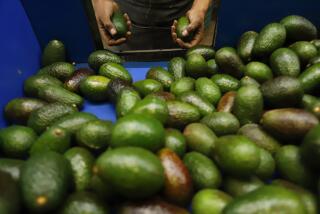Cuba Accuses U.S. of Waging Bug Warfare
- Share via
UNITED NATIONS — In an episode that mixed Cold War rhetoric with sci-fi conspiracy theory, Cuba on Monday accused the United States of sprinkling the island with the larvae of crop-destroying insects in an act of “biological aggression.”
The complaint of bug warfare--denounced as “ridiculous and without merit” by the U.S. State Department--came at U.N. offices in Geneva under terms of the 1972 Biological and Toxic Weapons Convention and marked the first time the treaty has been invoked.
Cuba’s deputy foreign minister, Maria de los Angeles Flores, told reporters in Geneva that Havana wants an international investigation of the incident, but Monday’s closed-door session, before signatories to the convention, adjourned without action. The hearing is scheduled to resume Wednesday after delegates have reviewed the U.S. response.
The dispute recalls earlier incidents of Cuban-American hostility, such as the time in the 1960s when the CIA reportedly considered killing Fidel Castro with an exploding cigar or asked the Mafia to put out a contract on the Cuban dictator.
“It was something out of a former era,” one diplomat in Geneva said of Monday’s hearing, which was called by Russia at Cuba’s request.
In documents filed with the United Nations in New York, Havana claims to have caught the U.S. red-handed when the pilot of a Cuban airliner on Oct. 21 spotted a small airplane registered to the U.S. State Department releasing “a white or grayish mist” over the Lenin State Horticultural Farm in Cuba’s Matanzas province, located directly south of Florida. Two months later, the potato crop on the Lenin farm became infested with what the Cubans called a “plague” of thrips palmi, a hardy pest that thrives in subtropical climates.
Cuba’s evidence is circumstantial, centering on the coincidence of the U.S. crop-duster over the site of the subsequent outbreak. In addition, its U.N. filing concedes that thrips palmi is common elsewhere in the Caribbean.
The State Department said the U.S. crop-duster had permission to fly over Cuba en route to Bogota, Colombia, where it was to be used in the eradication of illegal narcotics crops. The “mist” seen by the Cuban airliner crew actually was a smoke signal emitted by the U.S. pilot to alert the airliner to his presence, a spokesman for the U.S. Mission in Geneva said in a telephone interview Monday.
Moreover, the plane had no spraying equipment on board and the tanks normally used for pesticide were filled with auxiliary fuel for the long flight from the United States, the spokesman said.
*
In Washington, State Department spokesman James P. Rubin denied Cuba’s accusation and said, “We’re perfectly prepared to defend ourselves against this ridiculous charge.”
He said the United States agreed to attend the Geneva meeting to show its support for the international convention banning biological warfare.
Cuban officials say the infestation has spread to corn, bean, pumpkin and cucumber crops throughout western Cuba and has proved resistant to an emergency pesticide control program adopted shortly after the first outbreak.
Michael Parrella, chairman of the entomology department at the UC Davis College of Agriculture, said in a telephone interview that thrips palmi is widespread in the Caribbean and Central America and is often carried into a new area in plant material and even by hurricanes and monsoons. The pest is particularly destructive to young plants, Parrella added.
Times staff writer Norman Kempster in Washington contributed to this report.
More to Read
Sign up for Essential California
The most important California stories and recommendations in your inbox every morning.
You may occasionally receive promotional content from the Los Angeles Times.













